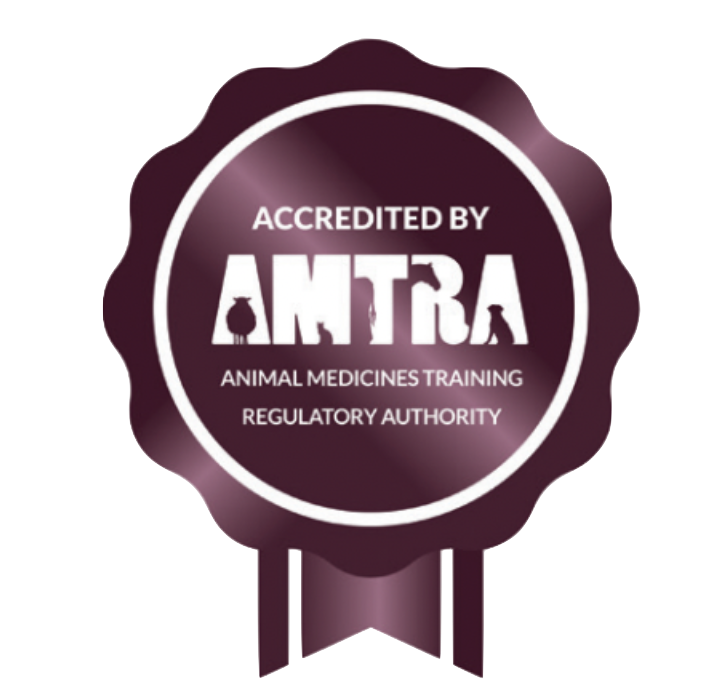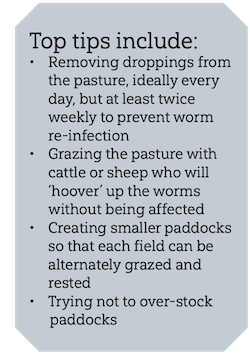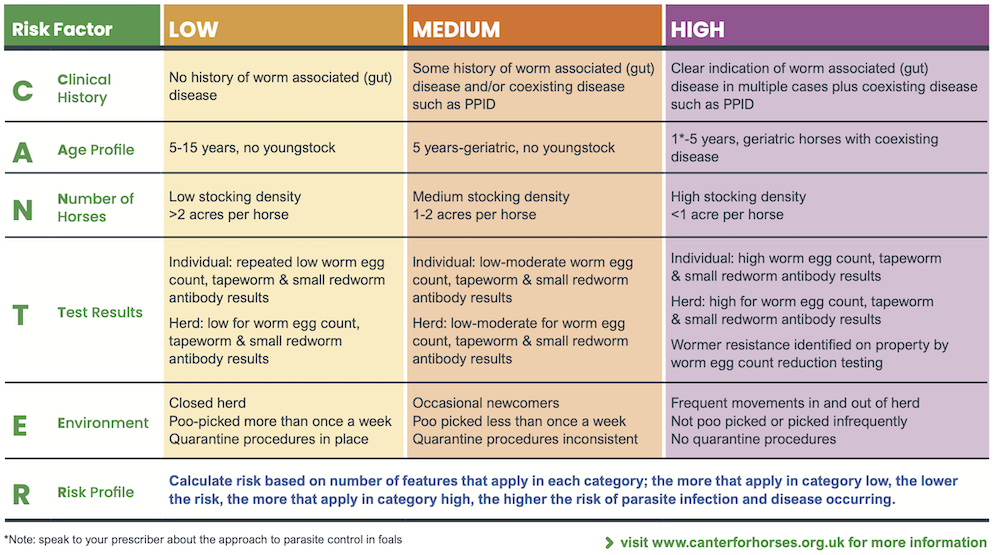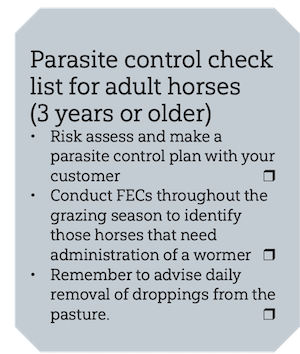

WORM CONTROL: Your customers’ questions answered
AMTRA is required by the Veterinary Medicines Regulations to ensure its RAMAs/SQPs undertake CPD. All RAMAs/SQPs must earn a certain number of CPD points in a given period of time in order to retain their qualification. RAMAs/SQPs who read this feature and submit correct answers to the questions below will receive two CPD points. For more about AMTRA and becoming a RAMA/SQP, visit www.amtra.org.uk
According to a recent survey more than 40% of horses are at moderate to high risk of parasite infection in the UK.1 This a significant number and serves to reiterate why we need to ensure that horse owners choose effective and sustainable worm management protocols.

RAMAs/SQPs are uniquely placed in equestrian retail environments to inform, educate and advise their customers on the best tactics for worm control, in line with the latest industry guidelines.
In this article Zoetis vet Wendy Talbot, answers some common questions you are likely to be asked about worm control. She covers why a diagnostic- led (using faecal egg counts (FECs) and antibody tests), worm control plan should be used, together with a yearly risk assessment to manage your adult horse’s worm burden to best effect.
How has domestication affected the worm challenge?
Our domestication of horses has changed the way in which they are able to manage parasitic challenges.
In the wild horses used to roam freely over thousands of acres, with continuous access to clean, fresh pasture. Worms and horses evolved together in this environment, developing a relatively healthy balance to maintain both populations.
Domestication has led to horses being kept on more restricted grazing, with limited opportunity to move onto cleaner pasture. This exposes them to worm re-infection at a much greater level, upsetting the horse/worm balance. This is why we have to intervene.
Breaking the lifecycle of parasites reduces the amount of worm challenge our horses face. Eggs are passed in the droppings, where they develop into larvae and contaminate the pasture, ready to be eaten by grazing horses.
An essential part of breaking the cycle is reducing the number of these stages on the pasture, keeping the number of larvae that the horse eats (challenge) to a minimum.
What causes resistance?
When a parasite population previously controlled by a drug is no longer susceptible to that drug it is known as resistance. The active ingredient of the horse wormer kills the sensitive parasites in the population, but those parasites not affected go on to create new generations of resistant parasites.2

Resistance affects the population of parasites which are found on the pasture and in the horse. This means that eventually any horse grazing the same pasture may pick up an infection of worms which cannot be effectively treated with the currently available wormers.
The incorrect use of wormers, including under-dosing, can cause resistance to occur, as can the effectiveness of the dewormer.2
However, the biggest cause of resistance is the indiscriminate overuse of de-wormers. Every time a de-wormer is administered it is only the usually small number of resistant parasites within that horse that will survive and multiply to contaminate the land with new resistant worms. If this situation is repeated, again and again then the majority of the parasites on that field or yard can become resistant to treatment.2
How do Faecal Egg Counts (FECs) work?
FECs measure the number of worm eggs in your horse’s dung and give an indication of how much your horse’s worm burden is contributing to pasture contamination. The number of worm eggs in the dung sample are measured and then reported as eggs per gram (epg). Encysted small redworm, tapeworm and bots will not show up in a standard FWEC.3,4
During the spring and summer, FECs can be used to guide appropriate dosing for redworm in adult horses (>3 years old). The interval between FECs is variable depending on the horse’s individual circumstances; however, every 2–3 months is a good place to start.5
If an FEC is more than 200 eggs per gram treatment may be recommended. A result of <50epg (no eggs seen) doesn’t guarantee that there were no eggs in the dung as only a very small sample is studied under the microscope.6
How can you test for ‘hidden’ worms?
FECs don’t reveal ‘hidden’ worms such as encysted small redworm or those that are only passed intermittently such as tapeworm, but saliva and blood tests can give an indication by measuring antibody levels.
It’s important to understand how antibody tests work: A horse with a high level of tapeworm infection will produce a large number of antibodies, which can be detected in blood or saliva. Depending on the results of a saliva or blood test you will be advised whether a worming medication is required. Because tapeworm antibodies can persist for several months after successful treatment, the results must be interpreted with care and the test cannot be used immediately after a worming medication to check that it has worked.
The small redworm test is also an antibody test but is currently only available on blood. It does not distinguish between encysted and other stages of small redworm, but with careful interpretation by a trained professional it can give an indication as to whether encysted stages may be present.7,8,9
How and when should risk assessments be conducted?
All horses respond differently to the same circumstances so it’s imperative to assess each one independently as well as of a part of the group in which it is kept, when you plan your worming tactics. Risk assessments should be performed any time a wormer is considered, and horses tested or treated depending on the level of risk.
CANTER (Controlling ANTiparasitic resistance in Equines Responsibly), the pan-industry group, formed in 2022 to tackle the increasing threat that wormer resistance poses to horse health has published the easy to use parasite risk table below.

How can I check the wormer has worked?
Faecal egg count reduction tests (FECRT) can be used to monitor the effectiveness of a wormer. They should be performed during the grazing season by taking an FEC immediately before and two weeks after worming to assess the level of worm eggs being shed. It is important to follow specific guidelines when doing this and it is advisable to have veterinary supervision so that the results can be interpreted correctly.4,10
Will deworming eliminate all the worms in my horse?
No, worming won’t kill all the worms and in fact it is beneficial that some survive. Refugia are the worms that, for whatever reason, remain unexposed to the wormer used at each treatment. These worms importantly contribute to the next generation of worms and may then be susceptible to the next wormer used. They helpfully counter the population of worms generated from resistant stock and it is thought that they are important in slowing the development of resistance. The largest and most important source of refugia is parasites on the pasture and those parasites in horses that are not treated. A smaller source is any stages not treated by a wormer (i.e. larval stages). 11
What impact do the seasons have on worms?
Parasite life cycles are linked to the seasons, which is why one of the first rules of worm control is to consider the time of year. The spring and early summer months present the ideal environmental conditions for the development of eggs and larvae on the pasture. This can lead to high pasture contamination and increase the potential for horses to acquire new parasite burdens, predominantly small redworms, which is why regular faecal worm egg counts (FECs) every 8-12 weeks from March to October, are so important.5
During the late autumn and winter most parasites are entering a less active phase and by winter the potential for further pasture contamination is reduced and encysted small redworm, tapeworm and bots will need individual attention.
Why do we need to weigh before worming?
Weighing your horse means you can administer an accurate dose of wormer. Accurate dosing helps to maintain the effectiveness of the wormers available. It’s particularly easy to under-estimate the weight of our horses if we guess, which can result in under-dosing and contribute to resistance.10
How often should foals be wormed?

Foals, with their reduced immunity, need a minimum of four wormer treatments in their first year. Traditionally, many foals received a far greater number of wormers, in some cases every month until six months of age.
Foals suffer from different parasites at different ages and it is crucial to tailor treatments appropriately. As a guide, foals should be wormed for ascarids at two and five months of age followed by worming for strongyles at nine and 12 months of age with an additional treatment at six months of age If strongyles are found on a faecal egg count.10
What is the best protocol for yearlings to three-year-olds?
Youngsters are usually more susceptible to worms than adult horses because they have had little chance to develop any immunity. They are more vulnerable to related diseases and tend to have higher egg shedding, which increases the risk of infection. FECs should be conducted at more frequent intervals than for adults to guide dosing during the grazing season and encysted small redworm, tapeworm and bots will need individual attention during the late winter.12
Do I need to worm my new horse straight away?
New horses with an unknown worming history should be quarantined and FEC tested. Test or treat for tapeworm and encysted small redworm on arrival. They should then be stabled for at least 48 hours to avoid bringing resistant worms onto your premises.
Why is pasture management so important?
Managing the pasture can reduce our reliance on wormers, reducing the drive for wormer resistance.12
References
- https://canterforhorses.org.uk/survey-shows-more-than-40-of-horses-at-moderate-to-high-risk-of-parasite-infection/
- Sangster N C (1999) Veterinary Parasitology 85. 189–204
- Hallowell- Evans C and Hallowell G (2017) Vet Times, April 24
- Lester HE and Matthews JB (2014) Faecal worm egg count analysis for targeting anthelmintic treatment in horses: Points to consider. Equine Veterinary Journal 46 (2014) 139–145
- Rendle D (2017) De-worming targeted plans. Vet Times, Equine, Vol.3 Issue 1 p16-18
- Nielsen MC. et al. Vet Parasit 2014; 202; 95−103.
- www.austindavis.co.uk
- https://www.austindavis.co.uk/small-redworm-blood-test
- Austin Davis: Elisa Kits. https://www.austindavis.co.uk/elisa-kits
- AAEP (2019) Parasite Control Guidelines
- Nielsen MK, Sauermann, C.W., Leathwick, D.M. (2019) The effect of climate, season, and treatment intensity on anthelmintic resistance in cyathostomins: A modelling exercise. Veterinary Parasitology, 269, 7–12,
- Matthews JB (2017) Helminth control programmes for equine yearlings at pasture. Veterinary Times; 47(8):22-22, 24.
.......

ABOUT ETN’S RAMA/SQP FEATURES
ETN’s series of CPD features helps RAMAs (Registered Animal Medicines Advisors/SQPs) earn the CPD (continuing professional development) points they need. The features are accredited by AMTRA, and highlight some of the most important subject areas for RAMAs/ SQPs specialising in equine and companion animal medicine.
AMTRA is required by the Veterinary Medicines Regulations to ensure its RAMAs/SQPs undertake CPD. All RAMAs/SQPs must earn a certain number of CPD points in a given period of time in order to retain their qualification. RAMAs/SQPs who read this feature and submit correct answers to the questions below will receive two CPD points. For more about AMTRA and becoming a RAMA/SQP, visit www.amtra.org.uk










